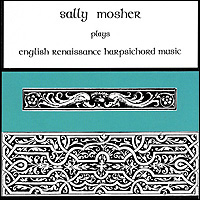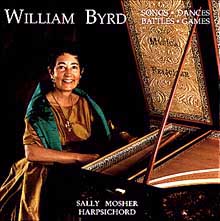| . | Home | Music | Videos | Photos | Paintings | Book Orders | Links | Contact |
|---|

presents... Sally Mosher | English Renaissance Harpsichord |
 Click for full size image |
| . | Home | Music | Videos | Photos | Paintings | Book Orders | Links | Contact |
|---|

presents... Sally Mosher | English Renaissance Harpsichord |
 Click for full size image |
A Bit of Harpsichord History
Two keyboard instruments appeared on the European musical scene during the 15th century – the clavichord and the harpsichord. The clavichord probably dates from the very beginning of the century, although the oldest surviving clavichords were made in Italy in the mid 16th century.
The earliest picture of a harpsichord dates from around 1450, and it is apparent from the picture that at that point the harpsichord’s mechanism was different from later instruments, since there is no jack rail. Italians are credited with the development of the instrument as we know it, but by the 16th century there were distinguished Flemish builders as well, most famously the Ruckers family.
Almost all the historical composers for harpsichord, from the first great composer, William Byrd of England (c. 1540-1623), and including the 18th century masters of the German and French Baroque, were organists. For the most part, they made their livings playing the organ, composing music for church and court, directing choirs, and teaching.
The English are especially associated with a type of harpsichord called a virginal. Contrary to popular mythology this is not because of the “Virgin Queen,” Elizabeth I, although she was a very proficient player on her Mother’s Italian-made virginal. Despite their famous association with the virginal, the English only began making their own virginals during the latter part of the 17th century.
In the Renaissance, harpsichords were most often used as solo instruments, their owners and players wealthy amateurs who played in private settings for their pleasure and that of a few friends. The great solo recital is a creature of the 19th century, and by then piano was the keyboard star. There were also court musicians who were employed just to play the harpsichord. One of the men executed along with Queen Elizabeth I’s virginal playing Mother, Anne Boleyn, accused of being her lover, was the court virginalist.
By Baroque times, harpsichords were used together with viola da gamba, and possibly a bass lute as well, to provide a harmonic and rhythmic underpinning (continuo) for other instruments in ensembles. The harpsichordist was sometimes the leader of the group, and was playing from a figured bass score. Many of these Baroque period harpsichords were exquisitely decorated, and a number still survive in playable condition in Europe.
The piano began to supplant the harpsichord in the last third of the 18th century. In general, by 1810 anyone who had been earning a living making harpsichords was either making pianos or out of business. Until the late 19th century, there ensued a period that I think of as “the long winter’s night” of the harpsichord. By the end of the 19th century, the stirring of interest in earlier music generated some interest in the harpsichord, but the 20th century resurrection of the harpsichord, first the “revival” instruments, and then our modern harpsichords, is a tale for another telling.
- Sally Mosher

As a musician, Sally Mosher has been active as pianist, newspaper music critic and feature writer, radio interviewer, teacher and concert manager, and presently concentrates on performing early music and her own compositions on the harpsichord and other keyboards. Mosher’s four CD’s reflect this focus: William Byrd: Songs, Dances, Battles, Games and English Renaissance Harpsichord Music (Musica Pristina), and From Now On: New Directions for Harpsichord and Images and Moods, featuring her compositions for harpsichord, synthesizer, violoncello and flute (New Mix). Information at www.NewMixMusic.com, the American Composers Forum (www.composersforum.org) and www.CDbaby.com. A new CD, Towards the Light, presents keyboard improvisations by Mosher and friends.
As a composer, Mosher has been described as “a chanteuse of the harpsichord ... a richly imaginative composer of bold musical strokes that cross musical barriers and move the harpsichord out of the 18th century salon and into our times.” Some of her works for harpsichord have been performed at The Library of Congress, the Berkeley and Athena Festivals, national early keyboard conferences, as well as in recitals. Mosher’s music has also been recorded by noted harpsichordist Elaine Funaro ("Dances with Harpsichords"; Centaur) nd dynamic young Welsh harpsichordist Christopher Lewis ("The New-Fangled Clavier”). Grammy winning pianist Gloria Cheng, now also a harpsichordist, has played Sally’s works in recital.
A researcher/Reader at the Henry E. Huntington Library, San Marino, Mosher is the author of the book People and Their Contexts: A Chronology of the Sixteenth Century World. She has presented early music lectures and lecture-recitals for the Renaissance Conference of Southern California, the Renaissance Society of America, California Institute of the Arts, the Shakespeare Roundtable, the UCLA Center for Medieval and Renaissance Studies, and the Shakespeare Oxford Society, among other venues, and has lectured on the harpsichord at the Central Conservatory in Beijing, China. Her articles on Renaissance music and other music topics have appeared in The Elizabethan Review, The Oxfordian Journal, the Southern California Early Music News Magazine, the San Francisco Bay Area Early Music News, and KUSC Members’ Newsletter.
Mosher studied at Manhattanville College and the University of Southern California for degrees in music history and piano, studying piano with Lillian Steuber, and harpsichord with Wm. Neil Roberts. She holds a Juris Doctor degree from the University of Southern California Law School, and is a member of the California Bar. She is President/owner of Oakhill Enterprises, a real estate investment business.
Long interested in contemporary music, Mosher is President of Piano Spheres Concerts (founded by Leonard Stein), a recital series presenting notable piano compositions of the 20th and 21st centuries at Zipper Concert Hall of the Colburn School of Performing Arts, Los Angeles. She is also a director of the Southern California Baroque Association. Increasingly active as an artist, Mosher paints colorful abstract canvases, designs jewelry, and has lectured on the history of jewelry.
"Elegant, sparkling playing, characterized by keen insight into
Renaissance style."
-- Wm Neil Roberts, harpsichordist
| Track Listing | ||
| THE ENGLISH RENAISSANCE SCHOOL OF COMPOSERS | ||
| 1. | Lady's Carey's Dump (Anon) | |
| 2. | Duke of Brunswick's Alman (John Bull) | |
| 3. | Chromatic Pavan (for Queen Elizabeth) (Bull) | |
| 4. | Rosasolis (Giles Farnaby) | |
| 5. | Amarilli di Julio Romano (Peter Philips) | |
| 6. | Pavana Hispanica (Sweelinck and Scheidt) | |
| 7. | Lord Salisbury Pavan (Orlando Gibbons) | |
| 8. | Lord Salisbury Galliard (Gibbons) | |
| 9. | The King's Hunt (Bull) | |
| MUSIC OF WILLIAM BYRD | ||
| 10. | Praeludium | |
| 11. | The First Pavan | |
| 12. | The Galliard to the First Pavan | |
| 13. | Wolsey's Wilde | |
| 14. | Alman | |
| 15. | La Volta | |
| 16. | Fortune | |
| 17. | The Carman's Whistle | |
| 18. | The Bells | |
Sound Samples
Click the white triangle to play each piece.
| Lady's Carey's Dump | ||
| Lord Salisbury Pavan | ||
| The Galliard to the First Pavan | ||
| The Carman's Whistle |
Downloads
Available from
iTunes
Available On Compact Disc
Catalog number: MP 102
Price: $15.99
Order online from CDbaby.com or pay by check or money order.
CLICK FOR INFORMATION ABOUT SALLY MOSHER'S BOOK:
People and Their Contexts:
A Chronology of the 16th Century World
Additional Releases by Sally Mosher
Click CD covers for more information
 |
 |
 |
||
| Sally Mosher: Images and Moods |
Sally Mosher: William Byrd: Songs · Dances · Battles · Games |
Sally Mosher: From Now On |
|---|
 |
 |
|
| Sally Mosher: Explorations |
Towards the Light Improvisations featuring Sally Mosher, Patrick Lindley, Justin Rizzo-Weaver, Scott Fraser |
|---|
© Copyright 2017 Sally Mosher
Webmaster's site: ElectricEarl.com